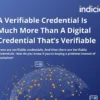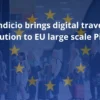The public sector is rarely seen as a driver of technological innovation; but when it comes to decentralized identity, some governments have been quick to embrace verifiable credential solutions. In our recent Indicio Meetup, we talked to three officials about why they chose this technology, how they implemented it, and why it created value.
By Trevor Butterworth
Wherever you are in the world, you’ve probably heard that your government is “behind the curve” in technology, probably from your media and perhaps even from your own political representatives. But this isn’t the case with decentralized identity technology — at least, for some governments. In a recent Meetup, Indicio CEO Heather C. Dahl asked three officials to talk about why they chose the technology, how they implemented it, and what was the result.
The officials were:
Nancy Norris, Senior Director of ESG & Digital Trust in the Ministry for Energy, Mines and Low Carbon Innovation for the Government of British Columbia
Elizabeth M. Tanner, Esq., Rhode Island Secretary of Commerce
Andin C.G. Bikker, Former member of the Parliament of Aruba and Former Minister of Justice and Integration of Aruba.
The Fear of being first
Governments are risk averse, which is unsurprising when it comes to IT; no one wants to be the author of an expensive disaster that could have been avoided with a little research or a more mature solution. But waiting for something to be well-vetted and a safe choice is also a source of inertia, particularly when it comes to technology that is constantly evolving.
“With government,” said Tanner, “what we hear is ‘we’re afraid of blockchain.’ They don’t know what it is, they’re afraid of any kind of security glitches, they’re not sure how it works. There is this fear of being first. Often the thinking is along the lines of ‘why don’t we let one of the other states try it out first?’”
Tanner spearheaded a project that used a distributed ledger network to store the records of those who had obtained a Certified Public Accountant (CPA) license. This would make it easier for CPAs to work across state lines and improve their professional standings, particularly when handling matters like tax returns in other states.
The way they overcame the generalized fear of the new going wrong, she said, was by starting small. They only tackled the CPA license; they ensured the user experience was as simple as possible, only consisting of a few forms; and they kept the old system for obtaining a license, so they had something to fall back on if there was a system failure.
Meeting the needs of business and the economy
In the case of British Columbia, the government was responding to the business community lobbying for the technology. Canadian companies wanted to use verifiable credentials to improve responsible mineral and natural gas sourcing, reduce carbon emissions, and to share that information with the marketplace. Verifiable credentials provided a secure, tamper-proof way of recording and sharing that information. “It’s a good news story for them,” said Norris, “it makes them more competitive. This is an opportunity to showcase the results of their hard work.”
With Aruba, an island economy entirely almost entirely dependent on tourism, Covid was a disaster. “All of a sudden,” said Bikker, “everybody realized… that we had to reinvent ourselves and that the technology would help us greatly in that aspect.”
Bikker was already investigating using verifiable credentials to make travel more appealing to tourists when the technology handed them a pandemic lifeline — a tamper-proof way to allow tourists prove their health status before arrival without complex integrations or data privacy issues.
What public sector use cases have in common
Uniting these diverse use cases was a common thread: Governments need to create easily verifiable data. That means tamper-proof, privacy-preserving, and securely-transmitted data. That means avoiding complex IT integrations and third party data management. That means data which can be shared and verified across different domains and ecosystems, which means interoperable technology.
Open-source decentralized identity technology provides all this—and in a way that is easy to deploy, meaning that government departments can quickly layer verifiable credentials into their existing systems, start with simple solutions, and then scale as needed. Indeed, Indicio designed Indicio Proven as a complete solution for simplifying the process of building solutions.
We highly encourage you to watch the full conversation, which goes into much more detail on the projects and advice for others interested in starting their journey into decentralized identity. You can find a recording of it on the Indicio YouTube channel.






